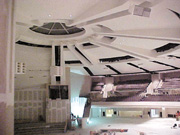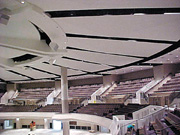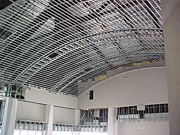

McElroy Specialty Interiors Inc., of Marietta, Ga., contracted with Beers/Legacy, of Atlanta, to engineer and design the cold-form metal framing systems, drywall systems, acoustical ceilings, acoustical wall panels, EIFS, insulation systems and glass-reinforced gypsum systems, in addition to other various specialty-labor tasks.
“I’ve never in my 18-year career seen a project of this magnitude and of this custom an installation be completed in such a short period,” says Randy Hardy, president and co-owner of MSI.

On the outside
The entire exterior wall system was engineered by MSI, some areas with 38-foot clear spans. The immense clear spans were due to economic considerations: It meant less structural steel and the use of cold-formed stud systems to achieve the longer spans. Also, there were very few intermediate steel fabrications to break up the clear spans, so cold-formed metal framing was engineered to accommodate the clear spans. Some areas were double, back-to-back 8-inch-by-14-gauge studs spaced at 8 inches on center.“With clear spans greater than usual, the amount of varying conditions made framing extremely difficult,” Hardy says. “It was a long process, but once engineered and approved, the drawings became a roadmap and it was like putting together an Erector Set.”
The exterior stud framing preconstruction and engineering process—from the time the drawings were initiated and went back and forth between the architect, engineer and GC—took more than two months to get completely approved. Every detail had to be covered: exterior walls, canopies, details on everything from windows and doors, to the huge louver openings and soaring clear spans.
However, as time-consuming as the process was, Hardy says, everyone at MSI enjoyed the challenge.
“The process we went through, from initial shop drawings to a final set of approved shop drawings was very palatable,” he says. “Being creative in exterior wall framing or design of interior systems is very exciting and we enjoy the creative process. Our industry is getting more creative all the time and we seem to now have more creative latitude from the architectural community.”
Dens-Glass sheathing was clad with Finestone EIFS once the exterior framing was complete. The EIFS was done through MSI by Southern Wall Systems. New Birth is the largest EIFS project MSI has taken on to date. Ninety percent of the building’s exterior is EIFS.
“We used roughly 100,000 square feet of EIFS,” says Benny Simms, of Southern Wall Systems. “It took us one year and that was with an accelerated schedule.”
That year began in January 2000, in the dead of winter, meaning rain and cold temperatures prevailed. Navigating the EIFS installation through these circumstances was tricky.
“You need 40 degrees and rising to install EIFS and it has to be dry,” Simms adds. “If there’s a 50-percent chance of rain, what do you do? If it rains within 24 hours of the installation, your work is a wash.”
Fortunately, the crew could stay busy by focusing on aspects of the installation not affected by weather when the weather didn’t cooperate.
In addition to weather challenges, a complex scaffold had to be erected for the project.
“There was a massive effort in mechanical lifts, staging and scaffolding to coordinate the framing, Dens-Glass and EIFS,” Hardy explains. “Between the heights and the quantities of EIFS installed, that was an amazing scaffold job.”

Into the sanctuary
Inside New Birth was 290,00 square feet of space that needed drywalling. It was a two-pronged drywall challenge. First, there were typical classrooms, common areas, lobbies, choir rehearsal areas and office spaces requiring drywall (a project in itself). Second was the main sanctuary.“The sanctuary is going to be a prototype for church programs across the country,” Hardy says. “The megachurch is a trend in the United States and there is a huge change in the religious community in the way people worship. The concept of the megachurch can offer community outreach programs that meet people’s needs and the smaller churches just can’t do it to the same extent.”
The sanctuary is a modern showplace, complete with huge TV monitors and state-of-the-art sound system. It also manages to be intimate, without a bad seat in the house, despite the size of the space. It measures 248 feet across the clear span and seats 8,000 to 10,000 people. Sizemore Floyd Architects Inc., of Atlanta, designed the space to make each person feel like the pastor is talking directly to him or her.
The architects designed a system of high NRC (while controlling the STC) spaces. This was done by installing on all rear exterior walls 2-inch-thick radius acoustical wall panels and drywall acoustical “clouds” on sloping ceilings and vertical surfaces. Conwed supplied MSI with the acoustical wall panels from its Design Scape system.
“The most unique thing was that they suspended drywall systems from structure and catwalks, and left intermediate voids between these systems to allow portions of sound to escape up in the plenum space of the sanctuary,” Hardy explains. “Some of the sound is being deflected back down and some is escaping through voids in the independently suspended system. MSI installed acoustical baffels to capture noise in the plenum space so it doesn’t bounce around and distort.”
The sanctuary ceiling itself is suspended from wires. Nothing rigid is attached to the main structure, which is 40 feet above the suspended wallboard.
“Everything is hanging off 8-gauge wires,” says Craig Sauers, MSI’s interior site manager. “Before the scaffold went in, we brought in 120-foot boom lifts and hung all the wires and sound baffels. I’d done suspended ceilings for other churches, but nothing of this magnitude. After doing this, give me anything you want!”
For constructing the sanctuary interior, GC Beers/Legacy installed a common scaffold so mechanical, electrical, drywall and other trades could use it simultaneously. All the trades had daily meetings on site to coordinate their work. The sanctuary ceiling had to be completed in five months and huge crews worked 10 to 12 hours each day, seven days a week to achieve these goals. From the beginning, the trades knew it would be a tight deadline, but the success of the project’s being completed on time depended on the sanctuary ceiling and perimeter.
“Prior to scaffolding, we prefabricated as many systems as we could, framing wise, so when the scaffold went up, the ceiling was already built.” Hardy says. “This was a very successful move because since everything was already built, we could start installing as soon as the platform was ready.”
The 13-month schedule was met and the church was ready for its Easter grand opening.
“It is the largest single effort I’ve seen where challenges were met and the quality was also the best,” adds Hardy, who has attended services at New Birth. “It’s worth the effort to be able to enjoy what you’ve helped to create.”
